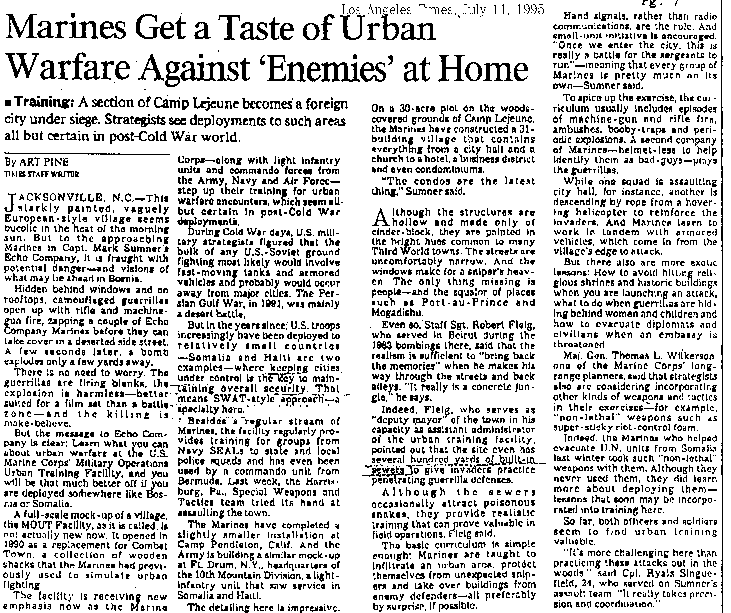Marines get a Taste of Urban Warfare Against 'Enemies' At Home
By Art Pine, Times staff writer
The Los Angeles Times (Washington edition)
July 11, 1995
This text was retyped for readability, cross reference, and comment.

Training: A section of Camp Lejeune becomes a foreign city under siege. Strategists see deployments to such areas all but certain in post-Cold War world.
Jacksonville, NC--This starkly painted, vaguely European-style village seems bucolic in the heat of the morning sun. But to the approaching Marines in Capt. Mark Sumner's Echo Company, it is fraught with potential danger--and visions of what may lie ahead in Bosnia.
Hidden behind windows and on rooftops, camouflaged guerrillas open up op with rife and machine-guns fire, zapping a couple of Echo Company Marines before they can take cover in a deserted side street. A few seconds later, a bomb explodes only a few yards away.
There is no need to worry. The guerrillas are firing blanks, the explosion is harmless--better suited for a film set than a battle zone--and the killing is make-believe.
But the message to Echo Company is clear: Learn what you can about urban warfare at the US Urban Training Facility, and you will be that much better off if you are deployed somewhere like Bosnia or Somalia.
A full scale mock-up of a village, the MOUT Facility, as it is called, is not actually new now. It opened in 1990 as a replacement for Combat Town, a collection of wooden shacks that the Marines had previously used to simulated urban fighting.
The facility is receiving new emphasis now as the Marine Corps--along with light infantry units and commando forces from the Army, Navy, and Air Force--step up their training for urban warfare encounters, which seem all but certain in post-Cold War deployments.
During Cold War days, US military strategists figured that the bulk of any US-Soviet ground fighting most likely would involve fast-moving tanks and armored vehicles and probably would occur away from major cities. The Persian Gulf War, in 1991, was mainly a desert battle.
But in the years since US troops increasingly have been deployed to relatively small countries--Somalia and Haiti are two examples--where keeping cities under control is the key to maintaining overall security. That means SWAT-style approach--a specialty here.
Besides a regular stream of Marines, the facility regularly provides training for groups from Navy SEALSs to state and local police squads and has been been used by a commando unit from Bermuda. Last week, the Harrisburg, Pa., Special Weapons and Tactics team tried its hand at assaulting the town.
The Marines have completed a slightly smaller installation at Camp Pendleton, Calif. And the Army is building a similar mock-up at Ft. Drum, NY, headquarters of the 10th Mountain Division, a light-infantry unit that saw service in Somalia and Haiti.
The detailing here is impressive. On a 30-acre plot on the woods covered grounds of Camp Lejeune, the Marines have constructed a 31 building village that contains everything from a city hall and a church to a hotel, a business district and even condominiums.
"The condos are the latest thing," Sumner said.
Although the structures are hollow and made only of cinder-block, they are painted in the bright hues common to many Third World towns. The streets are uncomfortably narrow. And the windows make for a sniper's heaven. The only thing missing is people--an the squalor of places such as Port-au-Prince and Mogadishu.
Even so, Staff Sgt. Robert Fleeing, who served in Beirut during the 1983 bombings there, said that the realism is sufficient to "bring back the memories" when he makes his way through the streets and back alleys. "It really is a concrete jungle," he says.
Indeed, Fleig, who serves as "deputy mayor" of the town in his capacity as assistant administrator of the urban training facility, pointed out that the site even has several hundred years of built-in sewers to give invaders practice penetrating guerrilla defenses.
Although the sewers occasionally attract poisonous snakes, they provide realistic training that can prove valuable in field operations, Fleig said.
The basic curriculum is simple enough: Marines are taught to infiltrate an urban area, protect themselves fro unexpected snipers and take over buildings from enemy defenders--all preferably by surprise, if possible.
Hand signals, rather than radio communications, are the rule. And small-unit initiative is encouraged. "Once we enter the city, this is really a battle for the sergeants to run"--meaning that every group of Marines is pretty much on its own--Sumner said.
To spice up the exercise, the curriculum usually includes episodes of machine-gun and rifle fire, ambushes, booby-traps and periodic explosions. A second company of Marines--helmet-less to help identify them as bad-guys--plays the guerrillas.
While one squad is assaulting city hall, for instance, another is descending by rope from a hovering helicopter to reinforce the invaders. And Marines learn to work in tandem with armored vehicles, which come in from the village's edge to attack.
But there also are more exotic lessons: How to avoid hitting religious shrines and historic buildings when you are launching an attack, what to do when guerrillas are hiding behind women and children and civilians when an embassy is threatened.
Maj. Gen. Thomas L Wilkerson, one of the Marine Corps' long range planners, said that strategists also are considering incorporating other kinds of weapons and tactics into their exercises--for example, "non-lethal" weapons such as super-sticky riot-control foam.
Indeed, the Marines who helped evacuate UN units from Somalia last winter took such "non-lethal" weapons with them. Although they never used them they did learn more about deploying them--lessons that soon may be incorporated into training here.
So far, both officers and soldiers seem to find urban training valuable.
"It's more challenging here than practicing these attacks out in the woods," said Cpl. Ryals Singuefield, 24, who served on Sumner's assault team. "it really takes precision and coordination."
Home: Museum Entrance
Search: Museum Text